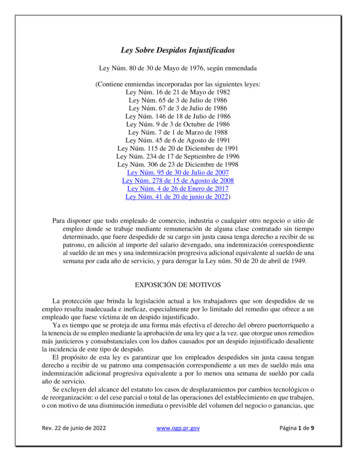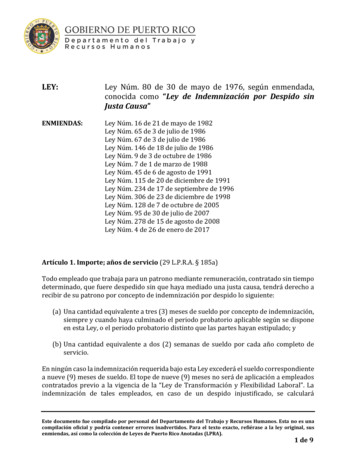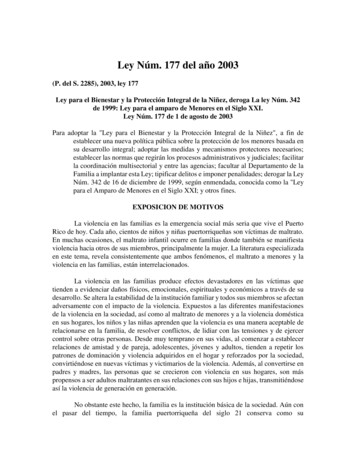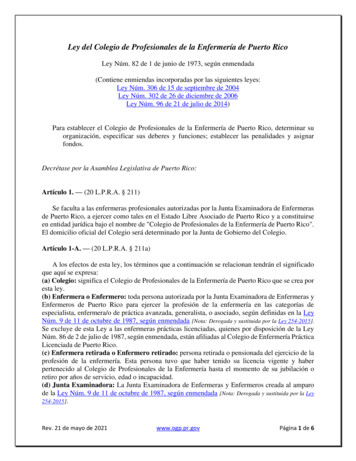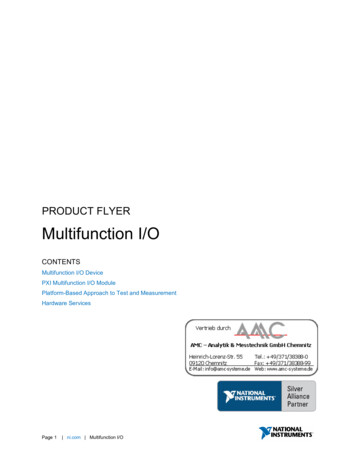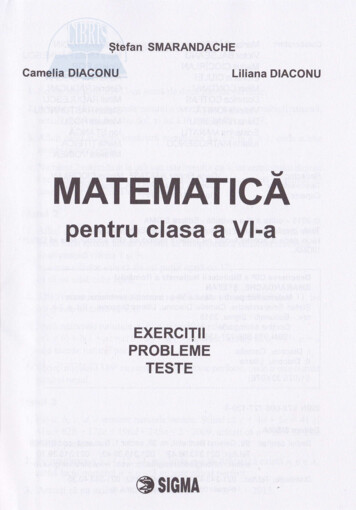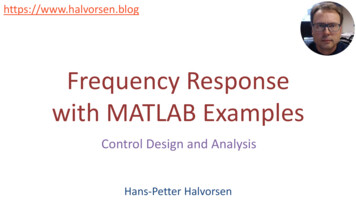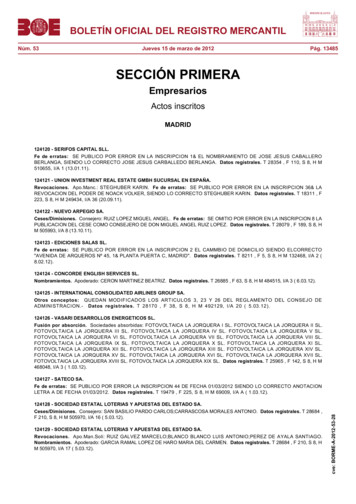
Transcription
23i-sources 23septembre 2011Sélection mensuelle d’articles et de documents sur le renseignement & la sécurité internationalepubliée par leA ctualité du r e n s e i g n e m e nTTerrorismePrivatisation d u r e n s e i g n e m e n tet de la s é cu r i téP rolifé ration et tra ficd ’armesForces et o pé r at i o n s spé c i a l e sC riminalit é et ma fiasGuerre de l’in f o r m at i o nc onf lits arm ésCybermenace sRisques internationauxPour être informé par courriel de la parutiondu prochain numéro To receive an emailalert on next issues: info@cf2r.orgCliquez pour accéder aux numérosprécédents Click to download previousissues: i-sources/indexpdflivrearticleaudio actualitÉ du renseignement Analytic Culture in the US Intelligence Community, an ethnographic studyDr. Rob Johnston, Center for the Study of Intelligence, CIA, mars 2005 Intelligence Legislation Model: ArgentinaThe Argentinean National Intelligence Law, 2001 and the Regulation of the National Intelligence Act, 2002This booklet contains the National Intelligence Law of Argentina as well as Presidential Decree 950 of 2002 whichwas required by the law and contains supplementary regulations. Argentina’s National Intelligence system includesthree agencies. The Intelligence Secretariat (SIDE), a civilian body, is the lead agency in the intelligence system. TheIntelligence Secretariat is responsible for collecting and producing intelligence and counter-intelligence on foreign anddomestic threats to the state. The National Directorate for Criminal Intelligence is a civilian body which is responsible forthe collection and production of criminal intelligence. Finally, the National Directorate for Strategic Military Intelligenceis responsible for collecting military intelligence; the intelligence unit of each branch of the armed forces fall under thepurview of this agency. Compilation de bonnes pratiques pour le contrôle des services de renseignementRapport du Rapporteur spécial sur la promotion et la protection des droits de l’hommeet des libertés fondamentales dans la lutte antiterroristeLes 35 bonnes pratiques identifiées dans cette compilation sont rassemblées dans quatre sous-domaines, à savoir lesfondements juridiques (pratiques 1 à 5), le contrôle et la responsabilisation (pratiques 6 à 10 et 14 à 18), le respect dudroit humanitaire substantiel (pratiques 11 à 13, et 19- 20) et les questions liées aux fonctions spécifiques des servicesde renseignement (pratiques 21 à 35). Cultural Topography: A New Research Tool for Intelligence AnalysisJeannie L. Johnson and Matthew T. Berrett, CIA, Studies in Intelligence Vol. 55, No. 2, juin 2011The more I observed the policy-intelligence dynamic, the more I perceived a need for an analytic construct designedexclusively to illustrate clearly and persuasively the inertia of culture. Cultural influences are typically touched on withinUS Intelligence Community (IC) analyses as peripheral factors, described with passing references, and often in generaland superficial terms. Although the IC is full of world-class expertise on foreign peoples, places, and organizations, thisindustry rarely isolates and illustrates culture as a factor deserving its own sophisticated and thorough treatment.I ntelligence Issues for Congress – Richard A. Best Jr., September 2011 - CRSInternational terrorism, a major threat facing the United States in the 21st century, presents a difficult analyticalchallenge, vividly demonstrated by the attempted bombing of a commercial aircraft approaching Detroit on December25, 2009. Counterterrorism requires the close coordination of intelligence and law enforcement agencies, but thereremain many institutional and procedural issues that complicate cooperation between the two sets of agencies.Particular challenges relate to the protection of civil liberties that surround collecting information about U.S. persons.RETOUR AU SOMMAIRE 1i-sources 23
23A lert and Ready: An Organizational Design Assessment of Marine Corps Intelligence – RANDAs the U.S. Marine Corps (USMC) has grown in strength, it has needed to add intelligence capabilities. Since the endof the Cold War and, especially, since September 11, 2001, USMC intelligence has had to tailor its organization to meetthe evolving demands of the operational environment. This has resulted in a number of ad hoc arrangements, practices,and organizations. A broad review of the organizational design of the USMC intelligence enterprise examined how toalign it efficiently and effectively with current and future missions and functions. Specifically, the review, which includedinterviews with a range of USMC personnel and civilians, considered the organization of (and possible improvementsto) the Intelligence Department, the Marine Corps Intelligence Activity, the intelligence organizations within the MarineExpeditionary Forces (specifically, the intelligence and radio battalions), and intelligence structures in the combat elements.A comparison of 48 organizational and functional issues with a series of USMC intelligence and functional issues resulted ina series of recommendations to help improve the «fit» of USMC intelligence organizations with their environmental context.In some cases, the service would benefit not from changing its intelligence structure but by realigning it; in other areas,restructuring would lend greater efficiency and effectiveness to the USMC intelligence enterprise. Studying Hostile, Deceptive, and Dangerous Surroundings Report of a Workshop on Social Research Methodsfor Non- Permissive Environments – David Last, Jordan Axani, Melissa Jennings, DRDCMost social research is conducted in permissive environments, which are safe (though not necessarily comfortable),straightforward, and not time-critical. Research to enhance human and national security must often answer questions inor about non-permissive environments. These may be hostile (people are trying to kill each other, if not the researcher),dangerous (with many non-intentional physical risks like landmines or crime), deceptive (at least some people are tryingto obscure the truth or mislead researchers, perhaps with hostile intent), manipulative (some people will try to use theresearch process for malign purposes), and time-critical because of the aims of the sponsor.This workshop brought together military and civilian social scientists and public servants with diverse backgrounds,some of whom have worked in non-permissive environments, with police, financial and economic analysts, pollsters,and intelligence experts to help triangulate methods to understand complex social processes in non-permissiveenvironments. Research tools can be applied to understand social phenomena from both within and outside nonpermissive environments.RETOUR AU SOMMAIRE P r i v at i s at i o n d u r e n s e i g n e m e n t & d e l a s é c u r i t é Making Intelligence Contracting Smarter: Reexamining Government Roles and Oversight –September 20, 2011Hearing on “Intelligence Community Contractors:Are We Striking the Right Balance?”Joshua Foust, Fellow, American Security ProjectTestimony prepared for the U.S. Senate Committee on Homeland Security and Government Affairs,Subcommittee on Oversight of Government Management, the Federal Workforce, and the District of Columbia.RETOUR AU SOMMAIRE F o r c e s e t o pé r a t i o n s s pé c i a l e sSAS War Diary, 1941-1945Created in 1946 and kept secret ever since, The Diary is one of the most astonishing manuscripts to come out of theSecond World War. It is the personal and private history of the Regiment from the inside, by the SAS for the SAS, in theirown words. It contains an unparalleled collection of documents, reports, photographs and maps and tells for the firsttime the full story of the SAS during World War 2. G u e r r e d e l’ i n f o r m at i o n From Infowar to knowledge warfare: preparing for the paradigm shift – Philippe Baumard, 1996We will investigate, in the footsteps of Hedberg, Jönsson, Starbuck, Steele, Wilensky, and many others, design principlesthat worked, and no longer worked. Founding our comments on observations of real-world experiences, we end withrecommendations as to prepare nations, organizations and people for the forthcoming paradigm shift: from InfoWar toKnowledge Warfare (K-Warfare).RETOUR AU SOMMAIRE CybermenacesCyber Events Since 2006 – By James Andrew LewisLast modified on September 29, 2011RETOUR AU SOMMAIRE 2i-sources 23
23Cyber Intelligence - setting the landscape for an emerging discipline – INSAThis paper is the first in a series developed by the Intelligence and National Security Alliance’s (INSA) Cyber Council. Itis intended to broaden the vision of senior decision makers in government and industry. Our goal with this paper is toset the landscape for cyber intelligence by discussing why it is necessary and providing thoughts on how to approachthe development of this function in the cyber domain. While there is a great deal of focus on current cyber securityissues, there is little focus on defining and exploring the cyber threat environment at a higher level. Its unique dynamicsand impact on our economy and national security are understudied. In this paper, we will focus primarily on defensivecyber activities. There is a rapidly increasing need to fully leverage cyber intelligence assets and capabilities on anational and global scale to address this ubiquitous, diverse, and evolving group of adversaries. There is also a need toclearly define an emerging cyber intelligence discipline that can be quickly and transparently shared with appropriateprivate and foreign partners. Rethinking Cybersecurity - A Comprehensive Approach – By James Andrew Lewis, James Andrew LewisJames A. Lewis gave a speech on September 12, 2011, at the Sasakawa Peace Foundation in Tokyo titled «RethinkingCybersecurity - A Comprehensive Approach.»RETOUR AU SOMMAIRE Terrorisme Countering Religion or Terrorism:Selective Enforcement of Material Support Laws Against Muslim Charities – Sahar AzizCounter-terrorism efforts have disproportionately targeted Muslim charities in the years following 9/11 as lawenforcement began to investigate charities and question donors. The policies have “effectively criminalized otherwiselegitimate charitable giving, peace-building efforts, and human rights advocacy. Consequently, the vitality anddevelopment of civil society within these communities has been significantly inhibited. The research suggests thatthe frozen assets of major Islamic charities including the criminal prosecution of their officers board members andfundraisers, alarmed Muslim donors. Aziz concludes that the policies enacted as a result of 9/11 are a failure tounderstand and live up to the core values of the US at its most fundamental level. Pursuant to Prevent: British Community Counterterrorism Strategy; Past, Present, and FutureH.A. Hellyer – 7/7/2011, IPSUISPU Fellow H.A. Hellyer covers the latest review of the UK’s ‘Prevent’ counterterrorism strategy, established in 2006 toprevent indigenous Muslims from embracing violent extremism, essentially through community engagement. Up until thepublication of this review, it seemed plausible that the British state would engage range of Muslim groups in to counterviolent radicalization, including non-violent Islamist groups. However, the review suggests that there is an over-archingideology shared by both non-violent Islamists and violent ones, and only those Muslims who were far removed fromIslamism and met a certain standard of integration could be engaged with by the government. Hellyer suggests a versionof the Prevent policy that addresses its flaws and ensures that it remains flexible enough to take note of changing on-theground realities. He further adds that the government should not stop engagement with non-violent Muslim lobby groupsthat may fall into the range of what constitutes extremism, especially for the purposes of counter-terrorism. Nigeria : accroissement et internationalisation des actions terroristes du groupe Boko HaramÉric Denécé, CF2RAvec près de 155 millions d’habitants, le Nigéria est, de très loin, le premier pays d’Afrique par sa population[1]. C’estaussi la deuxième puissance économique du continent, après l’Afrique du Sud. Situé aux confins de l’Afrique del’Ouest et de l’Afrique centrale, frontalier du Bénin, du Niger, du Tchad, du Cameroun, cet Etat occupe donc une placedémographique, économique et géopolitique de premier plan en Afrique. Ainsi, tous les événements qui s’y produisentont des conséquences pour la sécurité régionale.Depuis l’été 2011, une préoccupante dégradation de la situation sécuritaire s’observe au Nigéria, essentiellement dansle nord du pays. Elle est liée à la montée en puissance de l’islamisme radical et à sa manifestation violente, le terrorismedjihadiste, fait du groupe salafiste Boko Haram, dont on observe l’accroissement significatif des actions violentes. Homeland Security: Challenges for the Food and Agriculture Sector in Responding to Potential TerroristAttacks and Natural Disasters – GAO-11-946T September 13, 2011This testimony examines issues related to food and agriculture emergencies. Agriculture is critical to public health andthe nation’s economy. It annually produces 300 billion worth of food and other farm products and is estimated to beresponsible for 1 out of every 12 U.S. jobs. As a result, any natural or deliberate disruption of the agriculture or foodproduction systems--including natural disasters, disease outbreaks, and food contamination--can present a seriousthreat to the national economy and human health and can halt or slow trade. The food and agriculture systems are alsovulnerable to terrorist attacks, such as the intentional introduction of a foreign animal or plant disease or the intentionalcontamination of food products.RETOUR AU SOMMAIRE 3i-sources 23
23H omeland Security in Real-Time: The Power of the Public and Mobile TechnologyHeighington, Andrew – Homeland Security Affairs 7, Article 13 (June 2011)In the world of homeland security, mobile phones are too often viewed as detonation devices rather than vitalcommunication mechanisms to prevent terrorist attacks from occurring. It takes collective intelligence from federal,state, and local entities, as well as the public, to prevent terrorist attacks. Mobile technology empowers collectiveintelligence in ways that were never before possible. This essay argues that the nation’s crisis communication strategymust be broader and more innovative than commercial broadcast alerts, mobile text messages, and social media sitessuch as Facebook and Twitter. Federal, state, and local officials, in concert with the public, should adopt a strategy thatleverages mobile technology and harnesses the power of mobile applications that allow communication between thegovernment and individuals.Q uadrennial Homeland Security Review: Enhanced Stakeholder Consultation and Use of Risk InformationCould Strengthen Future Reviews – GAO-11-873 September 15, 2011The United States continues to face a range of evolving threats, such as the 2010 attempted attack on the nation’s aircargo system, that underscore why homeland security planning efforts are crucial to the security of the nation. TheImplementing Recommendations of the 9/11 Commission Act of 2007 required the Department of Homeland Security(DHS) to provide a comprehensive examination of the U.S. homeland security strategy every 4 years. In response, DHSissued its first Quadrennial Homeland Security Review (QHSR) report in February 2010 and a Bottom-Up Review (BUR)report in July 2010, to identify initiatives to implement the QHSR. As requested, this report addresses the extent towhich DHS (1) consulted with stakeholders in developing the QHSR, (2) conducted a national risk assessment, and (3)developed priorities, plans, monitoring mechanisms, and performance measures for implementing the QHSR and BURinitiatives. GAO analyzed relevant statutes and DHS documents on the QHSR and BUR processes and, in response toa request for comments on the processes, received comments from 63 of the 85 federal and nonfederal stakeholders itcontacted. Their responses are not generalizable, but provided perspectives on the processes. États-Unis : la neutralisation d’Al-Awlaki ou de l’emploi trop visible des services secretsAlain Rodier – CF2RAnwar al-Awlaki, un ancien imam américain d’origine yéménite -surnommé par Washington le «Ben Laden de l’Internet»- a été tué le 30 septembre 2011, à 150 kilomètres à l’est de Sanaa, la capitale du Yémen. Il a été éliminé par un missileHellfire tiré depuis un drone Predator, mis en œuvre par la CIA ; l’agence américaine avait en effet reçu l’ordre, en 2010,de le « neutraliser ».Il s’agit là d’une première, car aucun citoyen américain[1] n’a jamais fait l’objet d’une telle mesure, même au temps dela Guerre froide. Al-Awlaki a été désigné officiellement comme « élément terroriste » par l’ordre 13224 publié par ledépartement d’Etat américain. Toutefois, la polémique enfle aux Etats-Unis sur le non respect de la Constitution danscette affaire. Cette controverse aurait pu être évitée si aucune publicité n’avait été faite autour de cette opération. Le réseau Haqqani : acteur régional, ambitions mondiales – Aymeric JanierProtecteur d’Al-Qaïda, ce mouvement taliban autonome est considéré comme l’un des plus actifs en Afghanistan etdans les zones tribales pakistanaises. Mais son projet va plus loin : promouvoir le djihad à l’échelle mondiale. Avec, enligne de mire, un ennemi : les États-Unis. The Legality of U.S. Drone Attacks in Pakistan – Sikander Shah, IPSUISPU Legal Fellow Sikander Shah delves into the current debate surrounding the legality of U.S. drone attacks as selfdefense as well as the situation in Afghanistan and Pakistan. Examining the effectiveness of drones, Shah stipulates thatconsistent use of force actually augments the gravity of the threat of terrorism. Recommendations to stakeholders arealso put forth, including ending the United State’s use of aggressive military tactics and instead fostering nation-buildingthrough political dialogue. Mexico’s «Narco-Refugees»: The Looming Challenge for U.S. National Security – Strategic Studies InstituteSince 2006, when Mexican President Felipe Calderon declared war on the drug cartels, there has been a rise in thenumber of Mexican nationals seeking political asylum in the United States to escape the ongoing drug cartel violencein their home country. Political asylum cases in general are claimed by those who are targeted for their political beliefsor ethnicity in countries that are repressive or are failing. Mexico is neither. Nonetheless, if the health of the Mexicanstate declines because criminal violence continues, increases, or spreads, U.S. communities will feel an even greaterburden on their systems of public safety and public health from «narco-refugees.» Given the ever increasing crueltyof the cartels, the question is whether and how the U.S. Government should begin to prepare for what could be anew wave of migrants coming from Mexico. Allowing Mexicans to claim asylum could potentially open a flood gateof migrants to the United States during a time when there is a very contentious national debate over U.S. immigrationlaws pertaining to illegal immigrants. On the other hand, to deny the claims of asylum seekers and return them toMexico where they might very well be killed, strikes at the heart of American values of justice and humanitarianism. Thismonograph focuses on the asylum claims of Mexicans who unwillingly leave Mexico rather than those who willinglyenter the United States legally or illegally. To successfully navigate through this complex issue will require a greater levelof understanding and vigilance at all levels of the U.S. Government.RETOUR AU SOMMAIRE 4i-sources 23
23 P r o l i fé r a t i o n e t t r a f i c d ’ a r m e s “Véhicules civils militarisables” and the EU arms embargo on SudanKen Matthysen, Peter Danssaert, Brian Johnson-Thomas, Benoît Muracciole – IPISIn this case study we will focus on the use of European manufactured trucks in the Darfur region, and more speci!callywhat the defence industry calls “véhicules civils militarisables” - commercial vehicles that can be militarized. All armedactors in the con»ict require vehicles to transport combatants through the vast Darfur deserts. Japanese Toyota(Landcruisers) pick-up trucks are the most common vehicles that are spotted in the region. Usually they are mountedwith machineguns, and as such compose an important assault instrument. Furthermore, a wide array of military trucksor civilian trucks modi!ed for military purposes are being used in Darfur, e.g. anti-aircraft guns are mounted on a varietyof trucks to function as support and/or attack vehicles. Some of these trucks are European models, assembled by alocal company: GIAD Automotive Industry Company. BARDA Strategic Plan 2011-2016 – U.S. Department of Health and Human ServicesThe Plan describes our strategic goals and vision to accomplish BARDA’s mission over the next five years and beyondto develop and provide medical countermeasures for Chemical, Biological, Radiological, and Nuclear threats, pandemicinfluenza, and emerging infectious diseases. The implementation measures to achieve these strategic goals includesupport of product advanced development, stockpile acquisition, manufacturing surge capacity infrastructure building,and product innovation. These medical countermeasures include vaccines, biological and small molecule therapeutics,antiviral drugs and antibiotics, diagnostics, respiratory devices, and other medical supplies. Nuclear Nonproliferation: U.S. Agencies Have Limited Ability to Account for, Monitor, and Evaluatethe Security of U.S. Nuclear Material Overseas – GAO-11-920 September 8, 2011The United States has exported special nuclear material, including enriched uranium, and source material such asnatural uranium under nuclear cooperation agreements. The United States has 27 nuclear cooperation agreements forpeaceful civilian cooperation. Under the U.S. Atomic Energy Act of 1954 (AEA), as amended, partners are required toguarantee the physical protection of U.S. nuclear material. GAO was asked to (1) assess U.S. agency efforts to accountfor U.S. nuclear material overseas, (2) assess the Department of Energy’s (DOE) and U.S. agencies’ efforts to evaluatethe security of U.S. material overseas, and (3) describe DOE’s activities to secure or remove potentially vulnerableU.S. nuclear material at partner facilities. GAO analyzed agency records and interviewed DOE, Nuclear RegulatoryCommission (NRC), Department of State (State), and partner country officials. This report summarizes GAO’s classifiedreport issued in June 2011. Homeland Insecurity: Thinking About CBRN TerrorismMauroni, Albert J. – Homeland Security Affairs VI, no. 3 (September 2010)This essay examines the threat of chemical, biological, radiological, and nuclear (CBRN) terrorism and specificallywhat the Department of Homeland Security (DHS) has done to address this threat. The author suggests that DHS haserred by using DOD planning scenarios and DOD concepts for CBRN defense that are not easily applied to homelandsecurity. The DOD response to support state and local emergency responders is not appropriate for today’s conditions.The author identifies a methodology for reviewing DHS policies and suggests that there are more moderate, sustainablestrategies to address the threat of CBRN terrorism. How Reliable Is Intelligence on Iran’s Nuclear Program? – Barbara Slavin, 2011 Atlantic CouncilCollecting intelligence about Iran’s nuclear program has never been easy, and has been hurt by Iran’s spottycooperation with the International Atomic Energy Agency (IAEA) in recent years. Iran also has a long history of tellingless than the whole story about its nuclear work. It is not too late however for Iran to climb down the nuclear ladder,answer the IAEA’s questions and start again with a clean slate. The uncertainties surrounding intelligence about Iran’snuclear program are a reason for caution, not defeatism or despair. Arms Control and Nonproliferation: A Catalog of Treaties and AgreementsAmy F. Woolf, Mary Beth Nikitin, Paul K. Kerr – CRS, September 2011Arms control and nonproliferation efforts are two of the tools that have occasionally been used to implement U.S.national security strategy. Although some believe these tools do little to restrain the behavior of U.S. adversaries, whiledoing too much to restrain U.S. military forces and operations, many other analysts see them as an effective means topromote transparency, ease military planning, limit forces, and protect against uncertainty and surprise. Arms controland nonproliferation efforts have produced formal treaties and agreements, informal arrangements, and cooperativethreat reduction and monitoring mechanisms.RETOUR AU SOMMAIRE C r i m i n a l i t é e t MAf i a s Balance 2010 contra el crimen organizado y Estrategia española 2011 a 2014La Policía Nacional y la Guardia Civil han detenido a 6.369 personas y han desarticulado 554 grupos relacionados conel crimen organizado en España.RETOUR AU SOMMAIRE 5i-sources 23
23S ub-standard Ships and Human Costs of Piracy: The case of Captain Prem KumarBy Sam Bateman, RSISThe human costs of piracy off the Horn of Africa are mounting with an escalating level of violence and shipownersunwilling to pay higher ransoms while operating sub-standard ships. As the plight of Captain Prem Kumardemonstrates, innocent seafarers suffer most.National and international dimensions of criminal violence in Latin America – Benedicte Bull , April 2011Criminal violence has taken on epidemic proportions in several Latin American countries. While the violence hascomplex causes and expressions, a major reason behind the current surge in levels is the strengthening of transnationalcriminal organisations (TCOs), most of which are based on illicit drug trafficking. TCOs have fuelled a deepening ofmulti-faceted state crises, which in some cases may be characterised as the “criminalisation of the state”. The seminaron which this report is based focused on the causes of this wave of violence and policy responses at different levels.What makes countries vulnerable to transnational organised crime? – Ivan Briscoe, September 2011Countries emerging from conflict or other major crises face numerous difficult challenges on the road to state-building.One of the most harmful is the rise of violent crime, which threatens weak state institutions and the rule of law. In anumber of cases, this concern is accentuated by the presence of transnational organised crime. Instead of startingon a path of economic and institutional development, these nations are transformed into way stations on the route ofillicit products – drugs, clandestine migrants, or commodities such as timber or diamonds – heading to rich consumermarkets.S tate Fragility, Organised Crime and Peacebuilding: Towards a More Strategic ApproachJames Cockayne – Norwegian Peacebuilding Resource CentreFragile states, with their ready pools of unemployed labour, populations inured to violence and weakened statecapacity, offer sites of competitive advantage for militant organisations, criminal networks and political leaders alike.Collaboration among them may benefit all three – financing militancy, protecting crime and securing political control.Criminal networks threaten not only to fuel conflict, but also to undermine post-war gains – by criminalising politics andinstrumentalising continuing disorder, thereby creating pervasive fragility in the international system. Somali Pirates Have Rights too, Judicial Consequences and Human Rights ConcernsDeborah Osiro - ISS Paper 224The international community’s counter-piracy operation off the coast of Somalia has had limited success, despitea proliferation of initiatives and resources. Although the large military presence has increased the number of piracysuspects that are being brought to trial, it has not reduced the number of pirates taking to the high seas. Rather, theincreased militarisation and the strategies designed to bypass human rights obligations vis-à-vis the Somali pirates hasundermined the credibility of the counter-piracy initiatives. The regional piracy prosecutions in Kenya, in particular, haveraised various human rights issues, such as the failure to observe due process and the lack of appropriate jurisdiction.This paper highlights the fact that the strategy of enforcing legal accountability for pirates at sea but not for those onshore breeds a disregard for the human rights of a very vulnerable group of people, and results in an increase in piraticalactivities. Transnational Criminal Threats in El Salvador: New Trends and Lessons From ColombiaWestern Hemisphere Security Analysis Center of Florida International University, Miami, FloridaSince El Salvador’s civil war formally ended in 1992 the small Central American nation has undergone profound socialchanges and significant reforms. However, few changes have been as important or as devastating as the nation’semergence as a central hub in the transnational criminal “pipeline” or series of recombinant, overlapping chains ofroutes and actors that illicit organizations use to traffic in drugs, money, weapons, human being, endangered animalsand other products.RETOUR AU SOMMAIRE conflits armésThe US wanted a puppet, but made an enemy instead – Shaukat QadirThe United States seems to have a tremendous ability to make enemies of friends, allies, and possible friends and allies.Jalaluddin Haqqani, the leader of the Haqqani network, and his son, Sirajuddin, the group’s operational head, offer twoexamples. Measuring Success: Are We Winning? 1
As the U.S. Marine Corps (USMC) has grown in strength, it has needed to add intelligence capabilities. Since the end . at the Sasakawa Peace Foundation in Tokyo titled «Rethinking . Counter-terrorism efforts have disproportionately targeted Muslim charities in the years following 9/11 as law enforcement began to investigate charities and .
